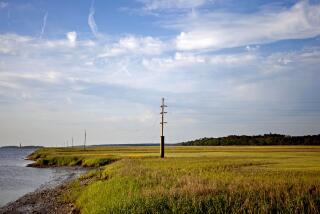Archaeologists unearth untold story of free blacks
- Share via
On Maryland’s Eastern Shore, a previously untold story of free African Americans is being told through newly discovered bits of glass, shards of pottery and oyster shells.
Piece by piece, archaeologists and historians from two universities and the local community are uncovering the history of The Hill, a part of the town of Easton believed to be the earliest community of free blacks in the United States, dating to 1790.
It also could have been the largest community of free blacks in the Chesapeake region. During the first census in 1790, about 410 free African Americans were recorded living on The Hill — more than Baltimore’s 250 free African Americans and even more than the 346 slaves who lived at nearby Wye House Plantation, where abolitionist Frederick Douglass was enslaved as a child.
Free African Americans in Easton lived alongside white families, said Dale Green, a Morgan State University professor of architecture and historic preservation who is working with the University of Maryland’s Mark Leone on the Hill project.
“It’s not just a black story. It’s an American story,” Green said.
Researchers and students are in the midst of a three-week dig at a property in the area. The census lacked details about the African Americans who lived there, but it does note the property owner was James Price, a white man who was the register of wills at the time.
Researchers and students are working in 5-by-5-foot squares. The deeper they dig, the further back in history they go.
The first few inches revealed 20th century artifacts — toys, marbles, pipe stems. But a little deeper, the team unearthed evidence of 19th century life, said Stefan Woehlke, a University of Maryland graduate student who is the site’s director.
Reaching into a meticulously labeled brown paper bag, he pulled out part of an olive green glass bottle with a decorative cluster of grapes on one side. It was probably used to hold wine, Woehlke said, and the technique used to make it — hand-blowing using a mold — dates it to the late 18th or early 19th century.
Other artifacts include bits of a blue opaline glass pitcher from the 1800s and a one-cent coin featuring Lady Liberty and dated 1794.
More important, researchers have found evidence of making nails and raising chickens — activities far more likely to have been carried out by free blacks who lived on the land than property owner Price.
As promising as the excavations on The Hill are — especially combined with document research and oral histories — researchers say they’re only scratching the surface.
“It’s sort of piecing together a puzzle, but you don’t have all the pieces,” Woehlke said.
The team has agreed to spend at least five more years working at The Hill, a commitment that’s welcomed in Easton, a town of about 16,000 residents on the Tred Avon River, which flows into the Chesapeake Bay.
Since the dig began at the Price property, more than 500 people have visited on organized tours or by wandering in after seeing signs announcing a “public archaeology excavation.”
Priscilla Morris, whose family has roots in Easton dating to the 1600s, is a regular visitor to the site. A member of the Third Haven Friends Meeting, a historic Quaker house of worship nearby, she’s intrigued by the role Quakers and Methodists played in freeing their slaves and advocating an end to slavery well before the Civil War.
“It’s thrilling because we suspected there was something here we didn’t understand,” Morris said.
Most written histories skip over the experience of free African Americans, said Morris, who has studied the local lore, including Douglass’ early life.
“It was really the plantation economy telling the story,” she said. “Nobody ever told us there was this extraordinary large free community.”
There are ambitious plans to get the word out about The Hill, including permanent and traveling museum exhibits, updated tourism initiatives and even a screenplay.
The Hill already is part of the National Register of Historic Places that includes Easton’s historic district, but that listing will be revised to include information about the African American history, “so when you read it, it’s not just about white Easton,” Green said.
Tracy Jenkins, a graduate student in archaeology at the University of Maryland, plans to write his dissertation on The Hill. He said the town’s interest and the warm reception has been encouraging and unique.
“That doesn’t happen so much in archaeology. Sometimes, archaeologists are digging off in a cornfield somewhere,” Jenkins said. He hopes to tell the story in a dissertation that matters, not one that “sits on a shelf.”
“I like the opportunity to tell stories that haven’t been told,” he said.
More to Read
Sign up for Essential California
The most important California stories and recommendations in your inbox every morning.
You may occasionally receive promotional content from the Los Angeles Times.










